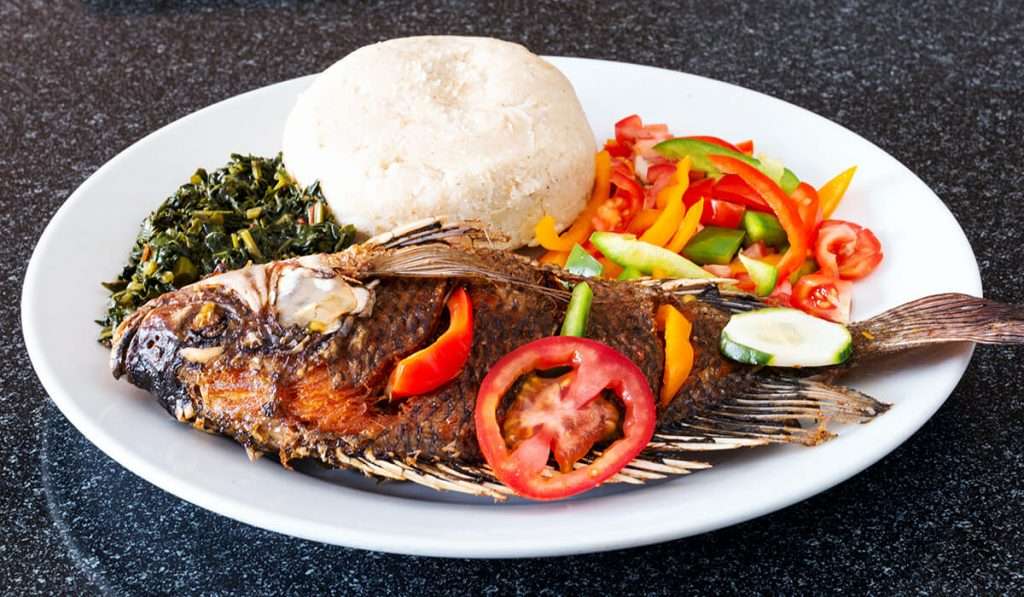A trip to Tanzania is only complete with experiencing its food. Tanzania’s culinary scene is a unique blend, combining centuries-old East African traditions with Indian and Middle Eastern influences to create unforgettable flavors. While you won’t find Tanzanian cuisine in many restaurants worldwide, that’s part of the charm – it’s a regional treasure meant to be experienced in its native home.
Food is a gateway to better understanding Tanzanian culture, and there’s no better way to learn than through shared meals. With ingredients from the land and spices inspired by trade, every dish reveals a rich history.
Hungry yet? Let’s take a culinary tour of Tanzanian food, from breakfast to dinner, and discover the must-try dishes you shouldn’t miss.
Breakfast

Tanzania’s mornings begin with simplicity. A typical Tanzanian breakfast is light, usually accompanied by coffee or tea.
Tanzania is known for its coffee farms, so if you’re a coffee lover, you’ll enjoy the rich, local brew. You might find “uji” – a sweet porridge made from millet or sorghum – which provides the energy needed for an active day.
Alongside uji, there’s chapatti, a type of flatbread brought by Indian influences, often served warm and fresh. Whether you choose tea, coffee, or uji, breakfast in Tanzania is about savoring simple yet filling dishes.
Lunch

Lunchtime is an essential part of the day in Tanzania. People often gather to enjoy their meal communally, usually eating with their hands.
The most prominent food on any Tanzanian plate is ugali, a starchy side made from cornmeal or sorghum. Ugali is more than just a food—it’s a Tanzanian staple everyone learns to appreciate.
Ugali is versatile and can be paired with sauces, vegetables, or meats. Meat is commonly part of Tanzanian meals, especially goat, beef, chicken, and fish. While vegetarians may have fewer options, beans and rice dishes and Indian-inspired vegetable curries are easy to find.
Dinner

As the sun sets, Tanzanian dinners mirror the lunchtime staples, often featuring grilled meats and ugali. By evening, the spices are more noticeable, significantly closer to the coast, where flavors like coconut and banana are commonly used.
A traditional dinner might include rice dishes spiced with local herbs and ingredients. Green vegetables or leafy sides accompany the starches and proteins, making Tanzanian meals hearty and balanced. And, if you crave a taste of home, Tanzanian streets are filled with “chipsi” – French fries that are often enjoyed as a quick side.
Dont forget
1. Tanzanian foods not to miss:
Aside from ugali, there are some must-try dishes for anyone visiting Tanzania.

Simple but elegant and filling, pilau is seasoned rice. Tanzania and its Zanzibar archipelago are famous for their historical spice trade, so you will find this Middle Eastern influenced rice dish everywhere. So. Good.
1. Ndizi kaanga

These are fried plantains or bananas, a very common and popular dish in East African and, more specifically, Tanzania. This is often served as a snack or as a side to a main course as something to push around with sauce or on their own.
What to Drink in Tanzania
Tanzania’s drinks offer as much variety as its food. For those who enjoy tea, chai – often sweetened and spiced – is a favorite, especially during colder months. You’ll also find soda and fresh juices from tropical fruits like mango, pineapple, and passionfruit.
Coffee lovers are in luck, too. Tanzania is a coffee-producing country, so the local coffee is robust and often enjoyed without additives to appreciate its full-bodied flavor. For a unique Tanzanian drink, try “dawa,” a mixture of honey, lime, and vodka, which Tanzanians say has a “healing” touch.
Traditional Etiquette Around Food
Sharing food is a significant cultural practice in Tanzania, and meals are often enjoyed communally. Eating with your hands is traditional, especially when enjoying dishes like ugali, where utensils are less common.
Respecting food and using your right hand to eat is customary in Tanzanian etiquette, as this practice symbolizes respect and gratitude for the meal. Another essential aspect of Tanzanian etiquette is appreciating the generosity of your hosts.
If you’re offered food, it’s courteous to try some, as this exchange is a heartfelt gesture. Embracing these customs will enhance your experience and create meaningful connections.
Embracing a Vegetarian Diet in Tanzania
For vegetarians, Tanzania offers a mix of options. Indian and Middle Eastern influences have brought vegetable dishes and lentil curries into Tanzanian cuisine.
Beans, rice, and seasonal vegetables are available and make up many meals. Fresh produce, from mangoes to avocados, can be found in local markets and complements the vegetarian diet well.
For those following a strict vegetarian or vegan lifestyle, communication is essential. Letting your hosts or restaurant staff know about your dietary preferences will help them accommodate your needs.
Experiencing Tanzanian Street Food
Exploring street food is one of the best ways to dive into Tanzanian cuisine. Whether in Dar es Salaam or a smaller town, you’ll find food vendors selling everything from skewers of nyama choma to fried cassava.
Try sambusas, a famous pastry filled with vegetables or meat. Street food is affordable and offers a quick way to sample local flavors on the go.
Be mindful when choosing street food. Opt for stalls with fresh ingredients and high turnover. This way, you can fully enjoy the authentic flavors without worry.
How to Stay Healthy While Tasting Local Delights
When enjoying food in Tanzania, it’s important to remember a few health tips. Generally, it’s best to avoid it if you can’t peel, cook, or boil it. Tanzanian markets are bursting with vibrant, locally grown produce, but wash and peel fruits before eating.
Staying hydrated is also crucial, so drink bottled water or bring a refillable filter bottle. With these tips, you can safely enjoy every meal, snack, and drink Tanzania offers.
Culinary Adventures Await in Tanzania!
Ready to experience Tanzania’s flavors? Every meal at a local market or fine-dining restaurant tells a story about this beautiful country’s history and culture.
Suppose you’re looking to dive deeper into Tanzania’s food culture. In that case, there’s no better way than through a guided culinary tour with Easy Travel for authentic and tailored Tanzanian experiences. Easy Travel can accommodate your dietary preferences and introduce you to local dishes to enhance your journey through Tanzania.
Discover the richness of Tanzanian cuisine on your next adventure! For more information on planning your trip, contact Easy Travel today and prepare for a feast as captivating as the country.
Join Us!
Ready to dive into Tanzanian culture through its vibrant food? From enjoying traditional dishes like ugali and nyama choma to exploring bustling local markets, each bite offers a taste of Tanzania’s rich heritage.
Contact us today to start planning your cultural getaway with Easy Travel, your trusted local tour operator. Get ready for an authentic culinary journey that brings Tanzania’s flavors and traditions to life!
Frequently Asked Questions (FAQs)
What is Tanzanian food culture like?
Tanzanian food culture is vibrant and rooted in communal dining and local ingredients. Meals are often shared with family and friends, fostering a sense of togetherness. Tanzanian cuisine reflects a blend of African, Arab, Indian, and Portuguese influences, making each dish unique with complex flavors.
Vegetables, meat, or beans are often served alongside staples like ugali (cornmeal porridge) and rice. Street food is widespread, and eating with hands is customary for certain dishes. Overall, food in Tanzania isn’t just about nourishment; it’s a celebration of community, heritage, and hospitality.
What are the most famous traditional Tanzanian dishes?
Some must-try traditional dishes in Tanzania include ugali, nyama choma (grilled meat), and pilau (spiced rice). Ugali is a cornmeal dish similar to polenta, often served with stews or sauces. Nyama choma, a grilled meat dish, is a favorite and frequently shared among groups, usually with a side of vegetables.
In coastal regions, dishes like samaki wa kupaka (fish in coconut sauce) and ndizi na nyama (plantains with meat) are popular. Each dish offers a glimpse into Tanzania’s diverse culinary influences and is often made with fresh, local ingredients.
What ingredients are commonly used in Tanzanian cuisine?
Tanzanian cuisine is based on locally available ingredients, including grains, meats, vegetables, and spices. Corn, millet, and cassava are everyday staples, while beans, spinach, and tomatoes are used frequently in dishes. The country’s historical trade connections include cloves, cinnamon, and cardamom.
Tanzania’s coastal regions rely on coconut milk for flavor, while inland areas incorporate more dairy. Meat, especially goat and chicken, is widespread, though fish is expected along the coast. These ingredients contribute to Tanzania’s unique, flavorful dishes.
Is Tanzanian cuisine vegetarian-friendly?
Tanzanian cuisine offers many vegetarian options, especially with staple ingredients like rice, beans, vegetables, and fruit. Maharagwe (bean stew) and mchicha (spinach with coconut) are popular vegetarian dishes. Additionally, Tanzanian markets are full of fresh produce, from mangoes and bananas to avocados.
Indian-inspired dishes like lentil curries also add variety for vegetarians. Though meat is widespread, vegetarian choices are available in most local restaurants. However, it’s helpful to communicate preferences clearly with your host or server for a strictly vegetarian or vegan diet.
What is a typical breakfast in Tanzania?
A typical Tanzanian breakfast is light, often consisting of tea or coffee, bread, or chapati (flatbread). Uji, a nutritious porridge made from millet or sorghum, is a popular breakfast item and provides energy for the day ahead.
You may find more options in urban areas, including eggs and fresh fruits. Coffee lovers will appreciate Tanzania’s high-quality local brews, as the country is known for its coffee-growing regions. Breakfast is usually straightforward but satisfying and reflective of regional tastes.
What are Tanzanian street food favorites?
Tanzanian street food is a must-try, with favorites like sambusas (fried pastries with meat or vegetable fillings), mishkaki (grilled meat skewers), and vitumbua (rice pancakes). Street vendors serve delicious snacks perfect for a quick bite while exploring.
In Zanzibar, be sure to try Zanzibar pizza, a savory and sometimes sweet stuffed pancake, or urojo, a tangy soup served with fritters. Street food in Tanzania is affordable and flavorful and gives travelers a taste of authentic Tanzanian flavors.
How is food traditionally eaten in Tanzania?
Eating with your hands is common in Tanzania, especially when enjoying dishes like ugali. Ugali is rolled into a ball to scoop up sauces, vegetables, or meat. Using the right hand to eat is customary, as it is seen as respectful in many African cultures.
Communal eating is also a big part of Tanzanian culture, especially during celebrations or large gatherings. Eating together strengthens social bonds, and Tanzanians are known for their hospitality and willingness to share meals.
What are some unique flavors in Tanzanian cuisine?
Tanzanian cuisine blends local and exotic spices, creating unique flavors. Coastal regions incorporate coconut milk in dishes, adding a creamy texture and taste. Inland, you’ll find heartier flavors with meat, corn, and dairy products.
Spices like cinnamon, cardamom, and cloves – influenced by Indian and Middle Eastern trade – add warmth to rice dishes and stews. Tamarind is also used for a tangy kick, particularly in sauces and chutneys, making Tanzanian food comforting and full of flavor.
What are must-try beverages in Tanzania?
Tanzanian drinks include chai (spiced tea), locally brewed coffee, and refreshing fruit juices from tropical fruits like mango, pineapple, and passionfruit. Tea is often enjoyed sweetened, with spices added for extra warmth, especially in colder regions.
For a more unique experience, try dawa (a local cocktail made with vodka, lime, and honey). Beer is also popular in Tanzania, with local brews like Safari Lager and Kilimanjaro Lager. Fresh juice stands and tea vendors are found in most towns, allowing you to sample traditional beverages easily.
Is Tanzanian food spicy?
Tanzanian food is flavorful but generally mild compared to Indian or Ethiopian cuisine. Some dishes, especially in Zanzibar, use spices like chili, but they’re typically adjusted to local preferences for moderate heat.
In rice dishes, you’ll find spices like cinnamon, cardamom, and cloves, but the spice level remains mild. Hot sauces or chili pastes are often served on the side if you prefer spicier food. This allows you to adjust the heat to your liking while enjoying the balanced flavors Tanzanian dishes are known for.
How does Tanzanian food reflect its culture and history?
Tanzanian food reflects the country’s diverse history and geography. Indian, Arab, and Persian influences are evident in pilau and sambusas. Coastal cuisine incorporates coconut and spices, influenced by historical trade with the Middle East and India.
Tanzanian food also reflects cultural values like communal eating, respect for hospitality, and sustainable use of local ingredients. Each dish represents the country’s connection to its land, people, and heritage, making the cuisine uniquely Tanzanian.
What is the best way to experience Tanzanian food?
The best way to experience Tanzanian food is through a guided culinary tour with a local operator like Easy Travel. From street food to home-cooked meals, a tour gives you a deeper understanding of the flavors, customs, and preparation techniques that define Tanzanian cuisine.
Dining at local eateries, exploring markets, and cooking with locals are all ways to immerse yourself in Tanzania’s food culture fully. You’ll have an authentic and memorable culinary experience with a knowledgeable guide.
What sweets or desserts are popular in Tanzania?
Popular Tanzanian sweets include mandazi (East African donuts), vitumbua (rice flour pancakes), and fresh tropical fruits like mango, banana, and papaya. Mandazi is often enjoyed with tea or coffee as a light treat, like a fluffy donut.
Try kashata, a famous peanut and coconut candy, on special occasions for something more unique. Tanzanian desserts often incorporate local ingredients and are mildly sweet, making them the perfect way to end a meal without overwhelming sweetness.
Are there food customs or etiquette to follow in Tanzania?
Tanzanian food customs include eating with your right hand and respecting the communal nature of meals. Eating with your hands is typical and traditional, particularly for dishes like ugali. Accepting food when offered is also respectful, as it reflects your host’s generosity.
When dining in a group, waiting for everyone to be served before beginning is customary. Following these simple customs will help you connect more meaningfully with Tanzanians and show respect for their culture.
What dishes are unique to Zanzibar?
Zanzibar, the Spice Island, has a distinctive cuisine influenced by Indian and Arabic flavors. Zanzibar pilau, a spiced rice dish flavored with cloves, cinnamon, and cardamom, is a must-try on the island. Samaki wa kipuka, a grilled fish with coconut sauce, is another local favorite.
In the streets, you’ll find “Zanzibar pizza,” a unique stuffed pancake that’s both sweet and savory. The influence of the spice trade on Zanzibar’s food makes it one of the most flavorful regional cuisines in Tanzania.
How can I try Tanzanian food with a local guide?
To fully experience Tanzanian cuisine, consider booking a culinary tour with a trusted local operator like Easy Travel. Easy Travel offers immersive culinary experiences, including market tours, local restaurant visits, and even cooking lessons with Tanzanian chefs.
With Easy Travel, you’ll sample the best Tanzanian dishes and learn about the cultural significance behind each meal. Contact Easy Travel to book a food tour and make your trip to Tanzania a delicious and culturally enriching adventure.



















